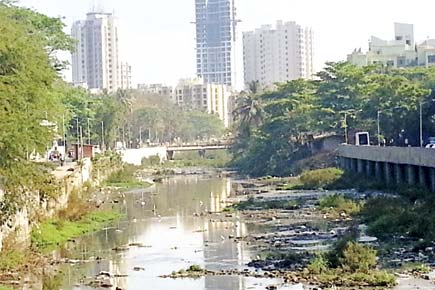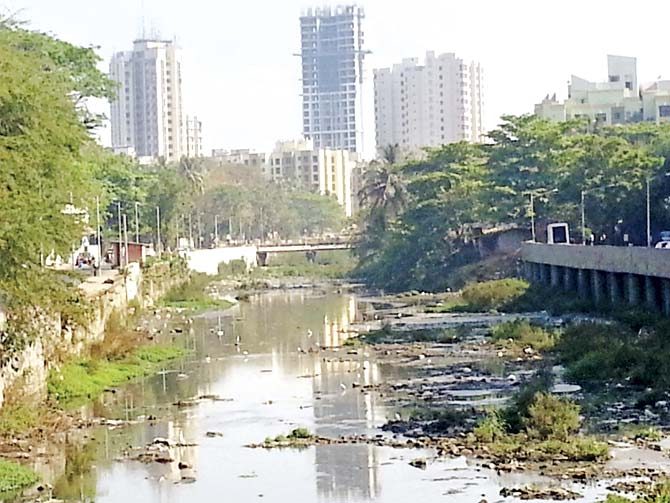A project seeks to use bioremediation a technique to start up natural metabolic processes that break down harmful chemicals in order to revive the picturesque river that was once the location for Bollywood films

Dahisar river, once an ideal shooting location for many a Bollywood director, has new hope. An initiative by local residents seeks to restore it to its former glory through a scientific clean-up and maintenance process. The group has also roped in an experienced environmentalist as a consultant for the job.

Dahisar River is currently a dumping ground for industrial effluents and construction debris
ADVERTISEMENT
The river is formed due to spillage of water from the Tulsi Lake, inside Sanjay Gandhi National Park, and ends in Gorai creek, travelling over 12 kilometres. In fact, Naya Daur, the hit film starring Dilip Kumar and Vyjanthimala, had it as one of the shoot locations.

Dr Anjana Pant (extreme right) with volunteers from Dahisar-based River Rehabilitation Regiment
However, thanks to the apathy of the civic body and unchecked expansion, the river is now a stinking gutter in which construction debris is dumped and industrial effluents are let out.
In order to undo the damage, River Rehabilitation Regiment (RRR), a Dahisar-based group, has approached Dr Anjana Pant, an environmentalist for help, who has been working in the field of remediation of heavy metals in aquatic bodies for over 20 years. Dr Pant, after an analysis, gave a cost-effective solution bioremediation.
The project will encompass various steps like cleaning the river of debris, directing the sewage/industrial effluent into the BMC sewage channels by building separate channels, building check dams for water retention and beautification of river front.
“Based on Dr Pant’s report, we have formulated a plan which includes procuring water quality data. It will be shared with people who reside along the river bank and the local school children to create awareness,” said a local resident and volunteer, Tejas Shah, a marketing professional.
Bajrang Aggarwal, another volunteer, who runs a data entry business, estimated the cost of recording scientific data and analysing it at approximately Rs 10 lakh and said they would approach corporate houses for funding, as they did not wish to involve political parties.
“Less than a year ago, a group of four friends from diverse fields of life decided to form a group to revive the Dahisar River. Today, we have more than eighty volunteers,” he said. RRR will also work with the civic body to ensure sewage and effluents are directed to proper channels and for the removal and rehabilitation of encroachments along the river.
Operation Revival
Dr Pant’s report states that till the late 1960s, crocodiles were witnessed to be residing in the river, but have now become extinct owing to the deteriorating condition of the water. It also underscores an important point just cleaning the river is futile without a component of awareness amongst stakeholders.
“During my research, we identified areas of encroachment (building, industries, and slums), which are virtually choking the river. Field observations indicate that the river is dumped with debris from construction activities and untreated industrial/residential wastes on the banks, and dumping of municipal solid wastes coupled with inadequate annual de-silting efforts add to the woes.
Modification of the river-course and local diversion of streams have compounded the risk of flooding,” said Dr Pant, who has identified a total catchment area of 3,488 hectares that needs to be enhanced. She added that once the data of pollutants present in the river is collected, bioremediation would be undertaken.
This is the process of introducing microbes in the river to start up natural metabolic processes to clean up harmful substances in the environment. These microorganisms feed on the pollutants and metabolise organic substances and oils, converting them into harmless substances like hydrogen and water.
This technique has had success in Kanpur and Allahabad, where it was observed that the vicinity of the drain became completely odour-free within the first two days, and the water became clearer and more transparent. “This is not a new concept. It happens in nature and can also be made to happen at sites where certain limiting factors do not allow it to take place.
Bioremediation offers several potential advantages that are useful for site managers, environmental regulatory agencies, government and the general public,” she said, adding that the same principle could be applied to the three other rivers in the city Poisar, Oshiwara and Mithi rivers all of which are in bad shape, despite crores of rupees having been spent over the years to restore them.
 Subscribe today by clicking the link and stay updated with the latest news!" Click here!
Subscribe today by clicking the link and stay updated with the latest news!" Click here!







